A potential new element in the changing face of geopolitics is emerging in the Southern Caribbean and this could present new opportunities for South America’s newest oil producing nation. So says Scott B. MacDonald, Chief Economist for Smith’s Research & Gradings, Fellow with the Caribbean Policy Consortium (CPC), Senior Associate at the Center for Strategic & International Studies (CSIS) and a Research Fellow at Global Americans.
Writing in his most recent column published on OilNOW on Sunday, MacDonald said India’s interest in buying Guyana’s crude represents an opportunity for the new oil producer to develop closer relations with a country that is not fully engaged in the U.S.-Chinese rivalry in the Caribbean.
“Although India has its problems with China, in the Caribbean India’s motivation is non-ideological; it is driven by business and the need to find other non-OPEC sources of oil,” he said.
As such, the Chief Economist said carving out a space in the Indian market makes considerable sense, both from a business and political risk point of view.
“There are a number of reasons for closer Indian-Guyanese oil trade,” MacDonald said. “First, in 2020 India was the largest buyer of the Maduro regime’s oil. Over the past few years much of this was done through third parties and efforts were made to remain compliant with U.S. sanctions.”
Second to this, he said Venezuela is increasingly a less reliable source of oil. The long years of the Chávez-Maduro regime have resulted in the degradation of PDVSA, the state-owned oil company. According to BP, Venezuela’s oil production in thousands of barrels per day was 3,038 in 2009; in 2019 it had fallen to 918. Venezuela’s oil production is back to 1940s levels.
“In contrast, Guyana’s oil production is on a strong upward trajectory,” MacDonald said, pointing out the ramp up in production to around 120,000 barrels per day at the end of 2020 and projections that see the country’s output approaching a million barrels per day by 2026.
He said beyond the decline of Venezuela’s oil industry, rule of law is tenuous in Caracas, while many basic staples are unavailable, and the regime is heavily implicated in criminal activities. Moreover, over five million Venezuelans have left the country, sparking what is Latin America’s worst refugee crisis.
“Third, while Venezuela struggles to be a reliable business partner, Guyana’s oil industry is new, run by Western companies, which have the most up-to-date technology and competent management and worker teams,” he stated. “The Guyanese government is also seeking to maintain a transparent process of selling oil, preferring an open system over striking bilateral deals.”
Platts sees low prospects for U.S. sanctions relief on Venezuela
Moreover, the government’s efforts to invest the money back into the economy and society are going to help it be a more reliable business partner. And, unlike Venezuela, expatriate Guyanese have returned to their homeland to work. “There is no Guyanese refugee crisis,” MacDonald pointed out.
He said Guyana has more in common with India than it does with either China or the United States. The two countries share having been British colonies as well as a democratic form of government which has had to contend with the ongoing challenges in dealing with multi-ethnic and religious groups.
“One other factor to be considered in the development of any Indian-Guyanese oil relationship is that it could set the stage for Suriname to sell its oil to India, which has enough demand to spread around. Suriname’s oil industry is less developed than Guyana’s, but it has had a state-owned oil company up and running for several decades and the oil that is beginning to flow is comparable to Guyana’s,” MacDonald stated.
Even though there is great interest from India to have a long-term agreement for the purchase of Guyana’s crude, Natural Resources Minister, Vickram Bharrat has told OilNOW the government prefers to have an open process. In fact, authorities are currently poised to select a marketer based on interest shown by several companies.
India wants oil from ‘stable geographies’ such as Guyana, Brazil and Norway
“Indeed, there is great interest from India through the High Commissioner here Dr. K.J. Srinivasa. He has been in constant contact with us. He met with President, Irfaan Ali; the Vice President, Dr. Bharrat Jagdeo; and myself concerning a long-term arrangement to purchase Guyana’s share of crude. However, we are not really in favour of any bilateral agreement especially when it comes to the oil and gas sector,” Bharrat said.
India, the world’s third biggest oil importer and consumer, ships in more than 80% of its oil needs from overseas and relies heavily on the Middle East. The nation’s gas demand is expected to increase nearly 3-fold from 229 million metric tonnes in 2018 to 607 million metric tonnes in 2040.




